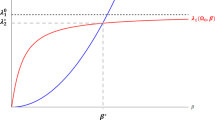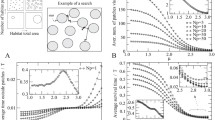Abstract
Through four spatially explicit models, we investigate how habitat fragmentation affects cyclic predator–prey population dynamics. We use a Partial Differential Equation (PDE) framework to describe the dispersal of predators and prey in a heterogeneous landscape made of high quality and low quality habitat patches, subject to increasing fragmentation through habitat separation and/or habitat loss. Our results show that habitat fragmentation decreases the amplitude of the predator–prey population cycles while average population density is not as strongly affected in general. Beyond these simple trends however, the four models show differing responses to fragmentation, indicating that when making predictions about population survival and persistence in the face of habitat fragmentation, the choice of model is important. Our results may inform conservation efforts in fragmented habitats for cyclic species such as the snowshoe hare and Canada lynx.
Similar content being viewed by others
References
Abrams, P.A., Ginzburg, L.R., 2000. The nature of predation: prey dependent, ratio dependent or neither? Trends Ecol. Evol. 15, 337–341.
Akcakaya, H.R., 1992. Population cycles of mammals: evidence for a ratio-dependent hypothesis. Ecol. Monogr. 62(1), 119–142.
Ali, S.W., Cosner, C., 1995. Models for the effects of individual size and spatial scale on competition between species in heterogeneous environments. Math. Biosci. 127, 45–76.
Bazykin, A.D., 1974. Sistema Volterra i uravnenie Mihaelisa–Menten. Voprosy Matematicheskoy Genetiki. Nauka, Novosibirsk.
Braza, P.A., 2003. The bifurcation structure of the Holling–Tanner model for predator–prey interactions using two-timing. SIAM J. Appl. Math. 63, 889–904.
Cantrell, R.S., Cosner, C., 1991. The effects of spatial heterogeneity in population dynamics. J. Math. Biol. 29, 315–338.
Cantrell, R.S., Cosner, C., 1998. On the effects of spatial heterogeneity on the persistence of interacting species. J. Math. Biol. 37, 103–145.
Cantrell, R.S., Cosner, C., 1999. Diffusion models for population dynamics incorporating individual behaviour at boundaries: applications to refuge design. Theor. Popul. Biol. 55, 189–207.
Cantrell, R.S., Cosner, C., 2001. Spatial heterogeneity and critical patch size: area effects via diffusion in closed environments. J. Theor. Biol. 209, 161–171.
Cantrell, R.S., Cosner, C., Fagan, W.F., 1998. Competitive reversals inside ecological reserves: the role of external habitat degradation. J. Math. Biol. 37, 491–533.
Cantrell, R.S., Cosner, C., Fagan, W.F., 2001. How predator incursions affect critical patch size: the role of the functional response. Am. Nat. 158(4), 368–375.
Dunning, J.B. Jr., Stewart, D.J., Danielson, B.J., Noon, B.R., Lamberson, R.H., Stevens, E.E., 1995. Spatially explicit population models: current forms and future uses. Ecol. Appl. 5(1), 3–11.
Fahrig, L., 2003. Effects of habitat fragmentation on biodiversity. Annu. Rev. Ecol. Evol. Syst. 34, 487–515.
Ginzburg, L.R., 1998. Assuming reproduction to be a function of consumption raises doubts about some popular predator–prey models. J. Anim. Ecol. 67, 325–327.
Hanski, I., Ovaskainen, O., 2000. The metapopulation capacity of a fragmented landscape. Nature 404, 755–758.
Hanski, I., Turchin, P., Korpimaki, E., Henttonen, H., 1993. Population oscillations of boreal rodents: regulation by mustelid predators leads to chaos. Nature 364, 232–235.
Holmes, E.E., Lewis, M.A., Banks, J.E., Veit, R.R., 1994. Partial differential equations in ecology: spatial interactions and population dynamics. Ecology 75(1), 17–29.
Kareiva, P., 1990. Population dynamics in spatially complex environments: theory and data. Philos. Trans. R. Soc. Lond. B 330, 175–190.
Krebs, C.J., Boutin, S., Boonstra, R., 2001. Ecosystem Dynamics of the Boreal Forest. Oxford University Press, New York.
Leslie, P.H., 1948. Some further notes on the use of matrices in population mathematics. Biometrika 35, 213–245.
Levin, S.A., 1974. Dispersion and population interactions. Am. Nat. 108, 207–228.
May, R.M., 1974. Stability and Complexity in Model Ecosytems. Princeton University Press, Princeton.
McKenzie, H.W., 2006. Linear features impact predator–prey encounters: analysis with first passage time. Master’s thesis, University of Alberta.
Moorcroft, P.R., Lewis, M.A., 2006. Mechanistic Home Range Analysis. Princeton University Press, Princeton.
Mowat, G., Slough, B., 2003. Habitat preference of Canada lynx through a cycle in snowshoe hare abundance. Can. J. Zool. 81, 1736–1745.
Murray, J.D., 1993. Mathematical Biology. Springer, New York.
Murray, D.L., 2000. A geographic analysis of snowshoe hare population demography. Can. J. Zool. 78, 1207–1217.
Neuhauser, C., 1998. Habitat destruction and competitive coexistence in spatially explicit models with local interactions. J. Theor. Biol. 193, 445–463.
Okubo, A., Levin, S.A., 2001. Diffusion and Ecological Problems: Modern Perspectives. Springer, New York.
Poggiale, J.-C., Auger, P., 2004. Impact of spatial heterogeneity on a predator–prey system dynamics. Biol. Model. 327, 1058–1063.
Poggiale, J.-C., Auger, P., Nerini, D., Mante, C., Gilbert, F., 2005. Global production increased by spatial heterogeneity in a population dynamics model. Acta Biotheor. 53, 359–370.
Poole, K.G., 1997. Dispersal patterns of lynx in the Northwest Territories. J. Wildlife Manag. 61(2), 497–505.
Poole, K.J., 2003. A review of Canadian lynx. Can. Field Nat. 117(3), 360–376.
Pulliam, R., 1988. Sources, sinks and population regulation. Am. Nat. 132, 652–661.
Rosenzweig, M.L., MacArthur, R.H., 1963. Graphical representation and stability conditions of predator–prey interactions. Am. Nat. 97(895), 209–223.
Ruggiero, L.F., Aubry, K.B., Buskirk, S.W., Koehler, G.M., Krebs, C.J., McKelvery, K.S., Squires, J.R., 2000. Ecology and Conservation of Lynx in the United States. University Press of Colorado, Boulder.
Ryall, K.L., Fahrig, L., 2006. Response of predators to loss and fragmentation of prey habitat: a review of theory. Ecology 87(5), 1086–1093.
Saez, E., Gonzalez-Olivares, E., 1999. Dynamics of a predator–prey model. SIAM J. Appl. Math. 59, 1867–1878.
Shampine, L.F., Reichelt, M.W., 1997. The MATLAB ODE suite. SIAM J. Sci. Comput. 18(1), 1–22.
Sherratt, J.A., Lewis, M.A., Fowler, A.C., 1995. Ecological chaos in the wake of invasion. Proc. Natl. Acad. Sci. USA 92(7), 2524–2528.
Sherratt, J.A., Eagan, B.T., Lewis, M.A., 1997. Oscillations and chaos behind predator–prey invasion: mathematical artifact or ecological reality? Philos. Trans., Biol. Sci. 352(1349), 21–38.
Sherratt, J.A., Lambin, X., Thomas, C.J., Sherratt, T.N., 2002. Generation of periodic waves by landscape features in cyclic predator–prey systems. Proc. R. Soc. Lond. B 269, 327–334.
Tanner, J.T., 1975. The stability and the intrinsic growth rates of predator populations. Ecology 56, 855–867.
Travis, J.M.J., French, D.R., 2000. Dispersal functions and spatial models: expanding our dispersal toolbox. Ecol. Lett. 3, 163–165.
Turchin, P., 2001. Complex Population Dynamics. Princeton University Press, Princeton.
Turchin, P., Batzli, G., 2001. Availability of food and the population dynamics of arvicoline rodents. Ecology 82, 1521–1534.
Tyson, R., Haines, S., Hodges, K., Modelling the Canada lynx and snowshoe hare population cycle: the role of specialist predators. J. Theor. Ecol., submitted.
Van Kirk, R.W., Lewis, M.A., 1997. Integro-difference models for persistence in fragmented habitats. Bull. Math. Biol. 59(1), 107–137.
Ylonen, H., Pech, R., Davis, S., 2003. Heterogeneous landscapes and the role of refuge on the population dynamics of a specialist predator and its prey. Evol. Ecol. 17, 349–369.
Yodzis, P., 1994. Predator–prey theory and management of multispecies fisheries. Ecol. Appl. 4, 51–58.
Author information
Authors and Affiliations
Corresponding author
Electronic Supplementary Material
Rights and permissions
About this article
Cite this article
Strohm, S., Tyson, R. The Effect of Habitat Fragmentation on Cyclic Population Dynamics: A Numerical Study. Bull. Math. Biol. 71, 1323–1348 (2009). https://doi.org/10.1007/s11538-009-9403-0
Received:
Accepted:
Published:
Issue Date:
DOI: https://doi.org/10.1007/s11538-009-9403-0




